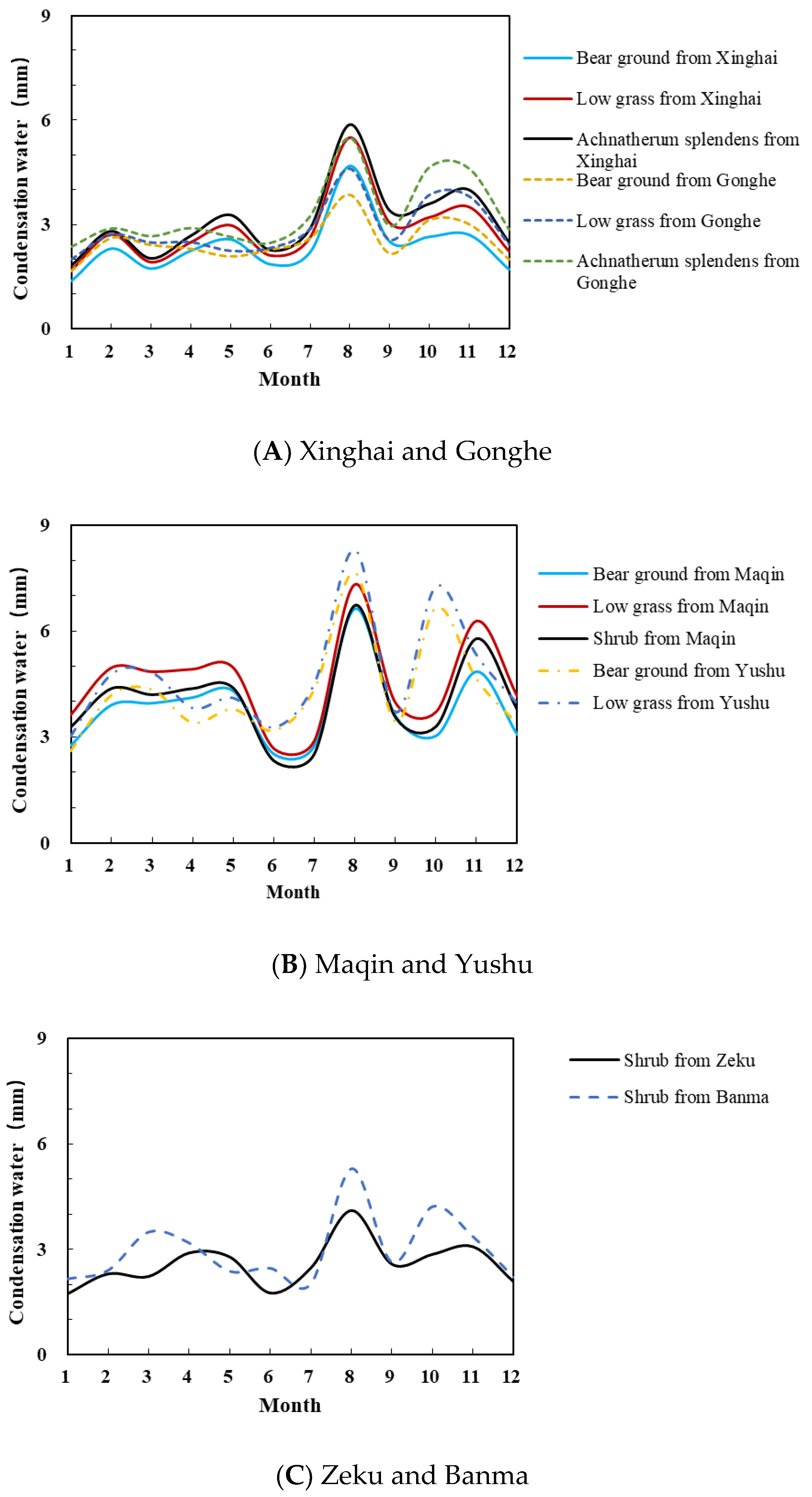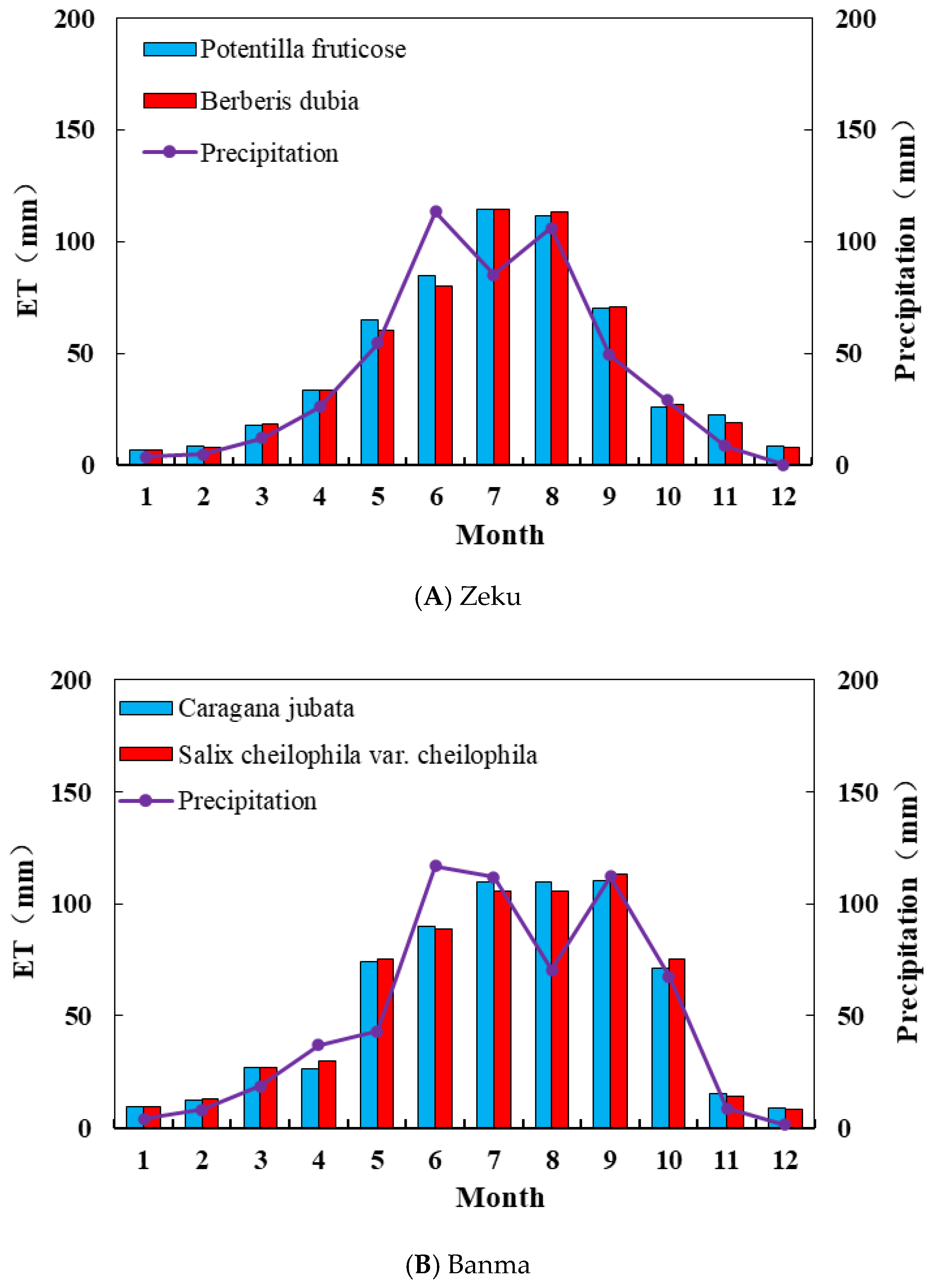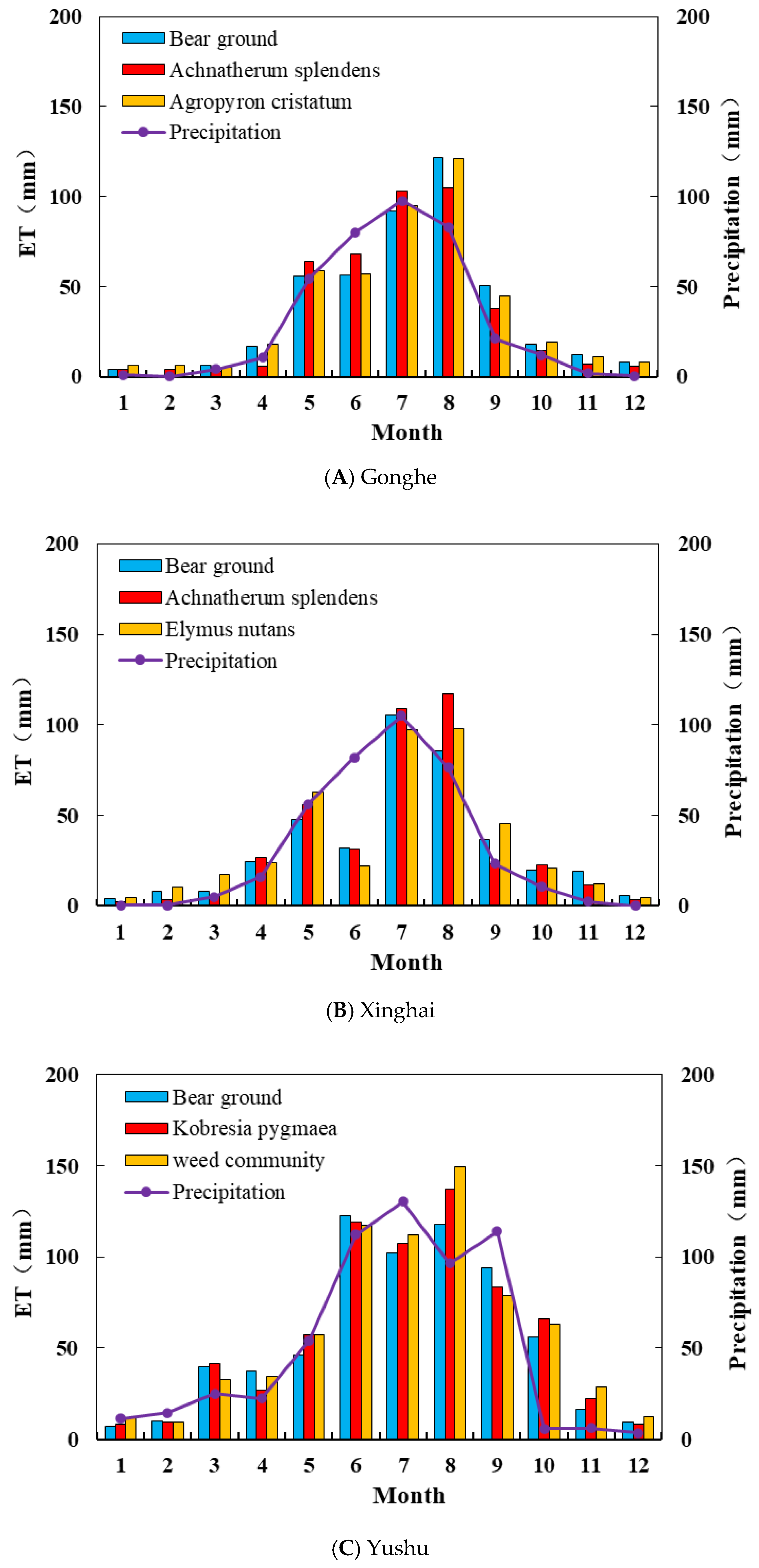Spatial Water Consumption Test and Analysis of Various Typical Vegetation in the Sanjiangyuan Region
Abstract
:1. Introduction
2. Materials and Methods
2.1. Overview of the Study Area
2.2. Test Plan
2.2.1. Equipment and Principle of Lysimeter
2.2.2. The Layout of the Evapotranspiration Field
2.2.3. Items and Frequency of Observation
2.2.4. Artificial Precipitation Simulation Test
2.2.5. Data Source and Processing
2.3. Estimating Condensation Water Using the Penman–Monteith Formula
3. Results and Analysis
3.1. Analysis of Condensation Water of Different Vegetation
3.2. Analysis of Water Consumption of Forage
3.3. Analysis of Water Consumption of Shrubs
3.4. Analysis of Water Consumption of Typical Communities
3.5. Analysis of Annual Runoff Yield
3.6. Relationship between Surface Runoff and Artificial Precipitation
4. Discussion
5. Conclusions
Author Contributions
Funding
Institutional Review Board Statement
Data Availability Statement
Conflicts of Interest
References
- Deng, X.Y.; Yao, J.Q.; Liu, Z.H.; Liu, Y. Spatiotemporal dynamic change characteristics of evapotranspiration in Tianshan Mountains from 2000 to 2014. Res. Soil Water Conserv. 2017, 24, 266–273. [Google Scholar]
- Ainsworth, E.; Rogers, A. The response of photosynthesis and stomatal conductance torising CO2: Mechanisms and environmental interactions. Plant Cell Environ. 2007, 30, 258–270. [Google Scholar] [CrossRef] [PubMed]
- Jamshidi, M. Evaluation of Evapotranspiration over a Semiarid Region Using Multiresolution Data Sources. J. Hydrometeorol. 2019, 20, 947–964. [Google Scholar] [CrossRef]
- Zhu, X.X.; Luo, T.Y.; Luo, Y.F.; Yang, Y.; Guo, L.Z.; Luo, H.Y.; Fang, C.Y.; Cui, Y.L. Calibration and Validation of the Hargreaves-Samani Model for Reference Evapotranspiration Estimation in China. Irrig. Drain. 2019, 68, 822–836. [Google Scholar] [CrossRef]
- Jamshidi, S.; Zand-Parsa, S.; Jahromi, M.N.; Niyogi, D. Application of a simple Landsat-MODIS fusion model to estimate evapotranspiration over a heterogeneous sparse vegetation region. Remote Sens. 2019, 11, 741. [Google Scholar] [CrossRef] [Green Version]
- Yan, X.; Mohammadian, A. Forecasting daily reference evapotranspiration for Canada using the Penman–Monteith model and statistically downscaled global climate model projections—ScienceDirect. Alex. Eng. J. 2020, 59, 883–891. [Google Scholar] [CrossRef]
- Chen, J.M.; Liu, J. Evolution of evapotranspiration models using thermal and shortwave remote sensing data. Remote Sens. Environ. 2020, 237, 111594. [Google Scholar] [CrossRef]
- Bastiaanssen, W.G.M.; Pelgrum, H.; Wang, J.; Ma, Y.; Moreno, J.F.; Roerink, G.J.; Van der Wal, T. A remote sensing surface energy balance algorithm for land (SEBAL). J. Hydrol. 1998, 212–213, 229. [Google Scholar]
- Pastorello, G.; Trotta, C.; Canfora, E.; Christianson, D.; Cheah, Y.W.; Law, B. The Fluxnet 2015 Dataset and the One Flux Processing Pipeline for Eddy Covariance Data; Nature Publishing Group: Berlin, Germany, 2020. [Google Scholar]
- Chu, H.; Luo, X.; Ouyang, Z.; Chan, W.S.; Dengel, S.; Biraud, S.C.; Zona, D. Representativeness of Eddy-Covariance Flux Footprints for Areas Surrounding Ameri Flux Sites. Agric. For. Meteorol. 2021, 301, 108350. [Google Scholar] [CrossRef]
- López-Urrea, R.; de Santa Olalla, C.; Fabeiro, C.; Moratalla, A. Testing evapotranspiration equations using lysimeter observations in a semiarid climate. Agric. Water Manag. 2006, 85, 15–26. [Google Scholar] [CrossRef]
- Granier, A.; Biron, P.; Breda, N.; Pontailler, J.Y.; Saugier, B. Transpiration of trees and forest stands: Short and long-term monitoring using sapflow methods. Glob. Change Biol. 2006, 2, 265–274. [Google Scholar] [CrossRef]
- Antezana-Vera, S.A.; Marenco, R.A. Sap flow rates of Minquartia guianensis in central Amazonia during the prolonged dry season of 2015–2016. J. For. Res. 2021, 32, 2067–2076. [Google Scholar] [CrossRef]
- Jamshidi, S.; Zand-Parsa, S.; Kamgar-Haghighi, A.A.; Shahsavar, A.R.; Niyogi, D. Evapotranspiration, crop coefficients, and physiological responses of citrus trees in semi-arid climatic conditions. Agric. Water Manag. 2020, 227, 105838. [Google Scholar] [CrossRef]
- Zhong, Y.; Zhong, M.; Mao, Y.; Ji, B. Evaluation of Evapotranspiration for Exorheic Catchments of China during the GRACE Era: From a Water Balance Perspective. Remote Sens. 2020, 12, 511. [Google Scholar] [CrossRef] [Green Version]
- Tyagi, N.K.; Sharma, D.K.; Luthra, S.K. Determination of evapotranspiration and crop coef®cients of rice and sunflower with lysimeter. Agric. Water Manag. 2000, 45, 41–54. [Google Scholar] [CrossRef]
- Chavez, J.L.; Howell, T.A.; Copeland, K.S. Evaluating eddy covariance cotton ET measurements in an advective environment with large weighing lysimeters. Irrig. Sci. 2009, 28, 35–50. [Google Scholar] [CrossRef]
- Zhou, B.R.; Han, B.H.; Xiao, H.B.; Zhou, H.K.; Li, P.; Yan, L.D.; Shi, M.M. Study on estimating diurnal evapotranspiration model of Alpine Marsh Meadow in Three-river Headwater Region. Acta Agrestia Sin. 2019, 27, 928–937. [Google Scholar]
- Ma, X.Z. Study on Ecological Water Requirement of Sanjiangyuan Region; Qinghai University: Qinghai, China, 2016. [Google Scholar]
- Wang, W.N.; Zhang, X.; Zhang, L.F.; Liu, X.Q.; Zhao, L. A comparison study of the evapotranspiration measured by lysimeter and eddy covariance. Chin. J. Ecol. 2019, 38, 3551–3559. [Google Scholar]
- Wang, X.Y.; Zhou, B.R.; Chen, Q.; Li, F.; Chan, C. Study on Water Consumption Law of Typical Alpine Meadow and Alpine Swamp Wetland Vegetation in Qinghai-Xizang Plateau. Plateau Meteorol. 2022, 41, 11. [Google Scholar]
- Han, S.P.; Jing, J.H.; Jing, L.; Gao, Q.Z.; Sun, J.C.; Wang, S. Observation and Research on Temperature Field and Coagulating Water. Acta Geosci. Sin. 2007, 5, 482–487. [Google Scholar]
- Wang, Y.Q.; Bao, Y.; Nan, S.L. Dynamic and Thermodynamic Effects on Climate Changes over the Qinghai-Tibetan Plateau in Response to Global Warming. Plateau Meteorol. 2019, 38, 29–41. [Google Scholar]
- Xu, Y.L.; Zhang, Y.X.; Lin, W.T. Analyses on the climate change scenarios over the Three Rivers’ Headstream Region in China. Clim. Environ. Res. 2007, 12, 667–675. [Google Scholar]
- Zhao, X.L.; Wang, J.B.; Ye, H.; Muhammad, A.; Wang, S.Q. The Bowen Ratio of an Alpine Grassland in Three-River Headwaters, Qinghai-Tibet Plateau, from 2001 to 2018. J. Resour. Ecol. 2021, 12, 305–318. [Google Scholar]
- Sun, H.L.; Zheng, D.; Yao, T.D.; Zhang, Y.L. Protection and Construction of the National Ecological Security Shelter Zone on Tibetan Plateau. Acta Geogr. Sin. 2012, 67, 3–12. [Google Scholar]
- Shao, Q.Q.; Liu, J.Y.; Huang, L.; Fan, J.W.; Xu, X.L.; Wang, J.B. Integrated assessment on the effectiveness of ecological conservation in Sanjiangyuan National Nature Reserve. Geogr. Res. 2013, 32, 1645–1656. [Google Scholar]
- Zhai, X.H.; Yan, C.Z.; Xing, X.G.; Jia, H.W.; Wei, X.X.; Feng, K. Spatial-temporal changes and driving forces of Aeolian desertification of grassland in the Sanjiangyuan Region from 1975 to 2015 based on the analysis of Landsat images. Environ. Monit. Assess. 2020, 193, 2. [Google Scholar] [CrossRef]
- Zhao, X.Q. Alhine Meadow Ecosystem and Global Change; Beijing Science Press: Beijing, China, 2009; ISBN 9787030226037. [Google Scholar]
- Zhang, M.D.; Zhang, L.F.; Chen, Z.G. Effects of evaporation and transpiration on evapotranspiration of degraded meadow in the Three-River Source Region. Acta Ecol. Sin. 2021, 41, 7138–7152. [Google Scholar]
- Jacobs, A.F.; Berkowicz, S.M.; Heusinkveld, B.G. Dew deposition and drying in a desert system: A simple simulation model. J. Arid Environ. 1999, 42, 211–222. [Google Scholar] [CrossRef]
- Stone, E.C. The Ecological Importance of Dew. Q. Rev. Biol. 1963, 38, 14. [Google Scholar] [CrossRef]
- Allen, R.; Pereira, L.; Raes, D.; Smith, M. Crop Evapotranspiration: Guidelines for Computing Crop Water Requirements; FAO Irrigation and Drainage Paper 56; FAO: Rome, Italy, 1998; p. 56. [Google Scholar]
- Guo, X.; Zha, T.; Jia, X.; Yang, Q.; Mu, J.; Liu, P. Estimation of dewfall amount in a typical desert shrub ecosystem. J. Beijing For. Univ. 2016, 38, 80–87. [Google Scholar]
- Liu, X. Characteristics of Soil Water and Heat under Freezing and Thawing Cycles in the Permafrost Regions of the Tibetan Platea; Lanzhou University: Beijing, China, 2020. [Google Scholar]
- Wang, Z.J.; Zhang, Z.X.; Suo, Y. A new water balance equation introducing dew amount in arid area. J. Hydraul. Eng. 2019, 50, 710–720. [Google Scholar]
- Cheng, L.; Jia, X.H.; Wu, B.; Li, Y.S.; Zhao, X.B.; Zhou, H. Effects of biological soil crusts on the characteristics of hygroscopic and condensate water deposition in alpine sandy lands. Acta Ecol. Sin. 2018, 38, 5037–5046. [Google Scholar]
- Xiao, H.; Meissner, R.; Seeger, J.; Rupp, H.; Borg, H. Effect of vegetation type and growth stage on dewfall, determined with high precision weighing lysimeters at a site in northern Germany. J. Hydrol. 2009, 377, 43–49. [Google Scholar] [CrossRef]
- Guo, B.; Chen, Y.N.; Hao, X.M.; Li, B.F.; Cao, Z.C. Characteristics of Soil Condensation Water and Its Influencing Factors on Different Underlying Surfaces in the Lower Reaches of the Tarim River. J. Nat. Resour. 2011, 26, 1963–1974. [Google Scholar]
- Liu, C.W.; Qiu, R.J.; Sun, Y.Q. The Evaluation of Soil Evaporation by the Micro-lysimeter with Different Material and Size in Maize and Winter Wheat Field. China Rural Water Hydropower 2018, 6, 1–5. [Google Scholar]
- Wang, R.H.; Ling, M.X.; Zhang, H. Study on Indoor Simulated Rainfall with Different Vegetation Coverage on Slope Erosion Reduction in the Three Gorges Reservoir Area. J. Soil Water Conserv. 2023, 37, 59–64. [Google Scholar]







| Evapotranspiration Field | Longitude (E) | Latitude (N) | Altitude (m) | Vegetation Type | Observed Vegetation |
|---|---|---|---|---|---|
| Zeku | 101°56′10.56″ | 35°16′50″ | 2941 | Alpine shrub | Shrub |
| Banma, | 100°52′17.5″ | 32°42′21.6″ | 3271 | Alpine shrub | Shrub |
| Maqin | 100°12′11.17″ | 34°28′48.85″ | 3775 | alpine meadow | Forage, typical communities |
| Yushu | 96°30′29.5″ | 33°12′42.4″ | 4161 | alpine meadow | Forage, typical communities |
| Xinghai | 99°58′48.06″ | 35°35′20.03″ | 3265 | Alpine grassland | typical communities |
| Gonghe | 100°12′25.17″ | 35°59′47.88″ | 3108 | Alpine desert grassland | typical communities |
| Evapotranspiration Field | Observed Vegetation | Number of Duplicates of Lysimeters | |
|---|---|---|---|
| Monthly Variation Test | Condensate Test | ||
| Gonghe | Bare ground | Three | \ |
| Achnatherum splendens community | Three | \ | |
| Agropyron cristatum (Linn.) Gaertn. var. cristatum community | Three | \ | |
| Xinghai | Bare ground | Three | \ |
| Achnatherum splendens community | Three | \ | |
| Elymus nutans community | Three | \ | |
| Maqin | Puccinellia tenuiflora | Four | Twelve |
| Poa annua var. annua | Twelve | Twelve | |
| Elymus nutans | Twelve | Twelve | |
| Stipa capillata | Twelve | Twelve | |
| Bare ground | \ | Three | |
| Kobresia community | \ | Three | |
| Potentilla fruticose community | \ | Three | |
| Yushu | Carex caespititia community | Twelve | Twelve |
| Kobresia pygmaea | Twelve | Twelve | |
| Bare ground | Two | Two | |
| Kobresia community | Three | Three | |
| Weed community | Four | Four | |
| Zeku | Potentilla fruticose | Twelve | Twelve |
| Berberis dubia | Twelve | Twelve | |
| Banma | Caragana jubata | Eight | Eight |
| Salix cheilophila var. cheilophila | Eight | Eight | |
| Evapotranspiration Field | Vegetation | Annual Condensation Water (mm) | Annual Condensation Water /Annual Precipitation (%) |
|---|---|---|---|
| Gonghe | Bare ground | 30.06 | 8.19 |
| Low grass | 34.32 | 9.35 | |
| Achnatherum splendens | 39.78 | 10.84 | |
| Xinghai | Bare ground | 28.47 | 7.54 |
| Low grass | 33.96 | 8.99 | |
| Achnatherum splendens | 37.15 | 9.84 | |
| Maqin | Bare ground | 45.42 | 7.10 |
| Low grass | 54.32 | 8.49 | |
| Shrub | 48.58 | 7.59 | |
| Yushu | Bare ground | 51.55 | 8.59 |
| Low grass | 56.88 | 9.48 | |
| Zeku | Shrub | 30.88 | 6.27 |
| Banma | Shrub | 35.88 | 5.98 |
| Vegetational Type | Evapotranspiration Field | Observed Vegetation | Vegetation Water Consumption (mm) | Percentage of Annual Water Consumption (%) | |||
|---|---|---|---|---|---|---|---|
| Non-Growing Season | Growing Season | All Year | Non-Growing Season | Growing Season | |||
| Forage | Maqin | Puccinellia tenuiflora | 65.9 | 434.0 | 499.9 | 13.18 | 86.82 |
| Poa annua var. annua | 56.9 | 496.7 | 553.6 | 10.28 | 89.72 | ||
| Elymus nutans | 59.9 | 473.7 | 533.6 | 11.23 | 88.77 | ||
| Stipa capillata | 57.7 | 484.7 | 542.4 | 10.64 | 89.36 | ||
| Yushu | Carex caespititia | 127.7 | 465.2 | 593.0 | 21.54 | 78.46 | |
| Kobresia pygmaea | 132.5 | 449.0 | 581.5 | 22.79 | 77. 21 | ||
| Shrub | Zeku | Potentilla fruticose | 96.6 | 470.7 | 567.3 | 17.04 | 82.96 |
| Berberis dubia | 92.6 | 465.5 | 558.0 | 16.59 | 83.41 | ||
| Banma | Caragana jubata | 99.1 | 564.8 | 663.9 | 14.92 | 85.08 | |
| Salix cheilophila var. cheilophila | 102.4 | 563.9 | 666.3 | 15.37 | 84.63 | ||
| Typical community | Gonghe | Bare ground | 48.4 | 395.2 | 443.6 | 10.92 | 89.08 |
| Achnatherum splendens community | 30.0 | 393.1 | 423.0 | 7.09 | 92.91 | ||
| Agropyron cristatum (Linn.) Gaertn. var. cristatum community | 56.1 | 396.2 | 452.3 | 12.40 | 87.60 | ||
| Xinghai | Bare ground | 69.6 | 326.6 | 396.2 | 17.57 | 82.43 | |
| Achnatherum splendens community | 53.2 | 359.5 | 412.6 | 12.88 | 87.12 | ||
| Elymus nutans community | 73.1 | 346.4 | 419.5 | 17.42 | 82.58 | ||
| Yushu | Bare ground | 120.3 | 539.0 | 659.3 | 18.25 | 81.75 | |
| Kobresia community | 116.8 | 570.5 | 687.3 | 17.00 | 83.00 | ||
| weed community | 129.4 | 578.3 | 707.7 | 18.29 | 81.71 | ||
| Evapotranspiration Field | Observation Month | Vegetation | Vegetation Coverage (%) | Vegetation Height (cm) |
|---|---|---|---|---|
| Maqin | May | Bare ground | 1.00 | 0.07 |
| Forage | 72.81 | 6.13 | ||
| Low grass community | 98.13 | 2.50 | ||
| Potentilla fruticose community | 98.00 | 30.00 | ||
| Zeku | May | Shrub | 86.25 | 32.09 |
| Banma | June | Shrub | 85.75 | 63.91 |
| Yushu | June | Bare ground | 1.75 | 0.08 |
| Forage | 97.71 | 11.88 | ||
| Low grass community | 94.17 | 5.50 |
Disclaimer/Publisher’s Note: The statements, opinions and data contained in all publications are solely those of the individual author(s) and contributor(s) and not of MDPI and/or the editor(s). MDPI and/or the editor(s) disclaim responsibility for any injury to people or property resulting from any ideas, methods, instructions or products referred to in the content. |
© 2023 by the authors. Licensee MDPI, Basel, Switzerland. This article is an open access article distributed under the terms and conditions of the Creative Commons Attribution (CC BY) license (https://creativecommons.org/licenses/by/4.0/).
Share and Cite
Qu, L.; Jia, S.; Li, R. Spatial Water Consumption Test and Analysis of Various Typical Vegetation in the Sanjiangyuan Region. Sustainability 2023, 15, 5422. https://doi.org/10.3390/su15065422
Qu L, Jia S, Li R. Spatial Water Consumption Test and Analysis of Various Typical Vegetation in the Sanjiangyuan Region. Sustainability. 2023; 15(6):5422. https://doi.org/10.3390/su15065422
Chicago/Turabian StyleQu, Liuyan, Shaofeng Jia, and Runjie Li. 2023. "Spatial Water Consumption Test and Analysis of Various Typical Vegetation in the Sanjiangyuan Region" Sustainability 15, no. 6: 5422. https://doi.org/10.3390/su15065422







